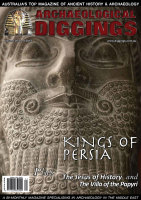Time magazine once said, “…the single most powerful figure - not merely in these two millenniums, but in all human history - has been Jesus of Nazareth.” 1 Our greatest works of art, poems, music and literature feature him. Even rock operas like Jesus Christ Superstar of the 70’s put him centre stage. Time is even divided into BC and AD because of Him. More recently the Da Vinci Code’s fictitious portrayal of Jesus caught the attention of millions around the world, becoming a bestseller 2 that sold 80 million copies as of 2009 3 and has been translated into at least 44 languages. But was Jesus real? Is He believable? This issue of Diggings examines these questions in an extensive article by Dr Nancy Vhymeister - The Jesus of History
Nancy’s article reveals that both historical documents and archaeology show that not only was Jesus of Nazareth a real person living 2000 years ago, but that the New Testament document’s portrayal of Him and His claims must be taken seriously. But was He who He and the New Testament writers claimed Him to be – the Messiah or Christ, the Almighty God in human flesh (see Matthew 26:63-65; John 1:1-3,14; 4:25,26; 10:30; 14:9; Revelation 1:8,17,18; 22:12,13)? Such claims confront us with philosopher, C. S. Lewis’ conclusion: Jesus must have been a liar (to claim to be God, if He knew He wasn’t), or a lunatic (crazy to make such wild claims), or who He said He was – the Lord God. Since His life reveals He was neither “mad” (crazy) nor “bad” (a liar) is there any evidence for the third possibility – that He is who He claimed to be – God in human flesh?
Two lines of evidences point to the fact that He was God in human flesh. Firstly there is the prophetic evidence. Biblical Scholars have identified over 300 Messianic predictions in the Old Testament books such as Psalms, Isaiah, Daniel, Micah and Zechariah. All of these predictions were originally made before 425 BC (approximate date of Malachi, the last book of the Old Testament) and include prophecies such as His: birth place; manner of birth; betrayal for 30 pieces of silver; crucifixion and resurrection. The New Testament documents claim numerous times that these prophecies met their fulfilment in the life of Jesus of Nazareth (for example Matthew 1:22; 2:15; 26:54; Luke 4:21; 24:44). The Dead Sea Scrolls, first discovered in 1947, contain parts of every book of the Old Testament except the book of Esther. Their discovery has revealed two things: 1. The Old Testament of today’s Bible is essentially the same as that of the Dead Sea Scrolls; 2. Since the Dead Sea Scrolls have been dated to be from 100 – 200 years before the time of Christ, therefore the prophecies they contain concerning the Messiah were clearly written long before Jesus of Nazareth appeared.
One such prophecy, found in chapter 9 of the book of Daniel, predicted that the Messiah would appear in 27 AD and be killed between 27 and 34 AD.4 Jesus Himself claimed to be the fulfilment of this incredible time prophecy when He proclaimed after His baptism in 27 AD, “The time is fulfilled…” (see Mark 1:15; Luke 3:1-22; Acts 10:38). In other words He claimed to be the Messiah of Daniel 9, which was also a claim to be God in human flesh (see John 4:25,26; Matthew 26:63-65). Which is why the great English scientist and mathematician, Sir Isaac Newton, who was also a keen student of Bible prophecy, speaking of Daniel 9:24-27, said, it is “the foundation stone of the Christian religion,” because it reveals that Jesus is the Messiah or Christ, God in human flesh. It is also explains why some Jewish Rabbis put this curse on those who read this passage: “May the spirits of those who attempt to calculate the final time [of Maschiach’s coming] expire” (Sanhedrin 97B, quoted in chapter 12 of Hilchos Melachim from the Mishneh Torah of Rambam).
The second line of evidence that the historical Jesus was God in human flesh is the countless lives down through the centuries that have been changed through an acceptance of Jesus and His teachings. Let me illustrate. I met Alexander Bolotnikov when we both participated in the Madaba Plains archaeological excavation project near Amman, Jordan in 1996. As a devout member of the Soviet Communist party he discovered that his application to attend the Moscow University was rejected simply because he was a Jew. Disillusioned over this, he quit the party and began to explore his Jewish heritage. During this time of his search for meaning in life, someone showed him Daniel 9:24-27. Immediately Bolotikov could see that Jesus of Nazareth was the fulfilment of this incredible prophecy and thus the Christ, God in human flesh. Putting his life in the hands of God, he found new meaning in life, along with hope for the future.
The Jesus of history certainly confronts each of us. C. S. Lewis put it this way: “I am trying here to prevent anyone saying the really foolish thing that people often say about Him: I’m ready to accept Jesus as a great moral teacher, but I don’t accept his claim to be God. That is the one thing we must not say. A man who was merely a man and said the sort of things Jesus said would not be a great moral teacher. He would either be a lunatic — on the level with the man who says he is a poached egg — or else he would be the Devil of Hell. You must make your choice. Either this man was, and is, the Son of God, or else a madman or something worse. You can shut him up for a fool, you can spit at him and kill him as a demon or you can fall at his feet and call him Lord and God, but let us not come with any patronizing nonsense about his being a great human teacher. He has not left that open to us. He did not intend to” (C.S. Lewis, Mere Christianity, London: Collins, 1952, p54-56).







